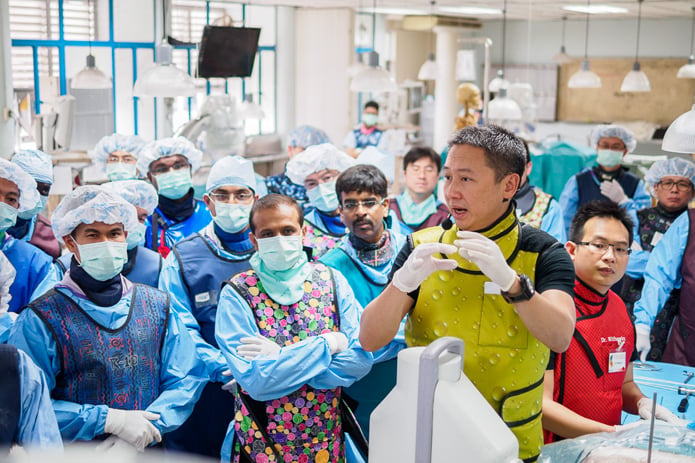Neck pain and back pain: Many patients suffer from chronic pain that can affect their daily activities. While neck and back pain have always been common in older adults, an increasing number of younger people are now also developing neck and back pain caused by overuse of digital devices, such as cellphones, computers, and communication devices.
Endoscopic spinal surgery is a highly effective new technique used to treat herniated discs, spinal stenosis, bone spurs, and slipped vertebrae. Developed by
Dr. Sebastian Ruetten, a highly respected Germany physician and Head of the Department of Spine Surgery and Pain Therapy at St. Anna Hospital in Germany, the procedure involves an endoscope being inserted through a very small (7.9 mm) incision. A camera at the end of the endoscope allows the surgeon to identify and remove the affected nerves without causing any surgical trauma to the surrounding tissue. This technique reduces patient recovery time and reduces the risk of complications after surgery.
This full-endoscopic spine and cervical surgical technique has become widely accepted by spine surgeons around the world. Bumrungrad Spine Institute headed by its director
Dr. Verapan Kuansongtham has been selected by Dr. Ruetten as Asia’s first and only training center for endoscopic surgery.
St. Anna Hospital of Germany and The Bumrungrad Spine Institute jointly organize full endoscopic lumbar and cervical spine surgery symposiums three times a year, twice in Germany and once at the Bumrungrad Spine Institute in Thailand.
Now in their 5th year, the workshops in Thailand are attended by surgeons from all over the world, especially from Asian countries. While roughly half of the participants are Thai, the remainders are from the United States, Europe, Brazil, Nigeria, Japan, Korea, Hong Kong, Taiwan, Malaysia, the Philippines, Vietnam, China, Iran, and India.

In 2014, the symposium in Thailand was attended by 41 surgeons, which is an increase on the number attending previous workshops. The first day included a lecture and a workshop on basic surgical techniques. The second day focused on more complicated techniques, and all participants participated in practical exercises with donor organs. Due to the increase in the number of participants this year, the number of operating tables was increased from 7 to 10.
The number of Thai surgeons attending the workshops has increased each year. While these surgeons come from public hospitals, private hospitals, and medical schools across the country, most are representatives of hospitals which have purchased the full-endoscopic spine surgery equipment. The workshops provide the surgeons with the opportunity to upgrade their expertise with this surgical technique, supporting the overall development of this field and eventually benefiting the general public at large.
The workshops also attract surgeons from the United States and China. After mastering the techniques at the training center in Thailand, a group of Chinese surgeons have performed the surgery on hundreds of patients in China. A training course has now been established in China, with surgeons from Bumrungrad Spine Institute invited to lead the training.
In a new development, Bumrungrad Spine Institute, in collaboration with Dr. Ruetten and Richard Wolf GmbH, a leading medical instrument manufacturer in Germany, launched their jointly-developed advanced endoscopic surgery last year. Using a 10.5 mm endoscope, this latest development further increases the potential for treating spinal instability.
The larger endoscope is used to remove fragments of bone from patients with spinal stenosis. In addition to reducing surgical time, this larger device can be used to treat an increased number of spinal conditions.
Aware of the importance of offering a wide variety of treatment techniques, the Bumrungrad Spine Institute plans to expand the next symposium to include an interbody fusion workshop on the treatment of spinal disorders or degenerative spine conditions.
Most patients suffering from these conditions have pain down their legs resulting from compression of the nerve. Radiating leg pain is usually caused by a narrowing of spaces in the spine, such as from a herniated disc. However, the most appropriate surgical technique depends on the results of each diagnosis.
Endoscopic surgery is mainly used to treat herniated discs, which can affect people of all ages. In the procedure, the compressed or herniated portion of the disc is removed. However, in older patients suffering from degenerative spine conditions which cause the spine to become loose and unstable, after the problematic disc is removed, an implant is inserted into the space to fuse the vertebrae together and provide stability.
The conventional interbody fusion requires a large incision and traumatic bleeding. In most cases, patients have to stay in hospital for about 5-7 days. The new
Transforaminal Lumbar Interbody Fusion (TLIF) technique requires a smaller incision and less traumatic bleeding. Patients can walk within 8-12 hours and only need to stay in hospital for 2 nights.
A team of surgeons at Bumrungrad have performed
TLIF surgery for more than 200 patients. The technique is less traumatic and time consuming. At the beginning of next year,
Dr. Verapan Kuansongtham’s team at Bumrungrad Spine Institute plans to organize a TLIF workshop for surgeons along the same lines as the endoscopic surgery workshop which has attracted an increasing number of participants.